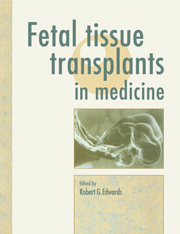Book contents
- Frontmatter
- Contents
- List of contributors
- Preface
- 1 Differentiation and transplantation of embryonic cells in mammals
- 2 Organogenesis and central nervous system development
- 3 Experimental human hematopoiesis in immunodeficient SCID mice engrafted with fetal blood-forming organs
- 4 Ontogeny of human T- and B-cell immunity
- 5 The procurement of human fetal tissues for clinical transplantation. Practice and problems
- 6 Transplantation of fetal haemopoietic and lymphopoietic cells in humans, with special reference to in utero transplantation
- 7 The biology of fetal brain tissue grafts: from mouse to man
- 8 Clinical results of transplanting fetal pancreas
- 9 The suitability of fetal and infantile donors for corneal transplantation
- 10 Transplantation of ovaries and testes
- 11 Cell grafting and gene therapy in metabolic diseases
- 12 The low temperature preservation of fetal cells
- 13 Law and ethics of transplanting fetal tissue
- Appendix: Code of practice on the use of fetuses and fetal material in research and treatment
- Brief bibliography on various aspects of transplanting fetal 337 tissue
- Index
Preface
- Frontmatter
- Contents
- List of contributors
- Preface
- 1 Differentiation and transplantation of embryonic cells in mammals
- 2 Organogenesis and central nervous system development
- 3 Experimental human hematopoiesis in immunodeficient SCID mice engrafted with fetal blood-forming organs
- 4 Ontogeny of human T- and B-cell immunity
- 5 The procurement of human fetal tissues for clinical transplantation. Practice and problems
- 6 Transplantation of fetal haemopoietic and lymphopoietic cells in humans, with special reference to in utero transplantation
- 7 The biology of fetal brain tissue grafts: from mouse to man
- 8 Clinical results of transplanting fetal pancreas
- 9 The suitability of fetal and infantile donors for corneal transplantation
- 10 Transplantation of ovaries and testes
- 11 Cell grafting and gene therapy in metabolic diseases
- 12 The low temperature preservation of fetal cells
- 13 Law and ethics of transplanting fetal tissue
- Appendix: Code of practice on the use of fetuses and fetal material in research and treatment
- Brief bibliography on various aspects of transplanting fetal 337 tissue
- Index
Summary
THE SUBJECT OF THIS BOOK has held my interest for many years. It was greatly stimulated in 1962, in John Paul's laboratory in Glasgow University, as we saw various types of tissue differentiate in outgrowths of stem cells from rabbit blastocysts. The implications of the work led me to the concept of using human blastocysts to obtain tissue cultures of stem cells for human grafting, and became one of the driving forces leading me to undertake human in vitro fertilization. Success has not come easily in obtaining these cell outgrowths from human embryos, although there are now promising leads in this direction. I trust that my dedication to the clinical application of this field is reflected in the pages of this book, and that it will stimulate more studies on grafting fetal tissue. The book focusses on one of the many clinical uses of fetal tissue: for grafting into sick fetuses, children and adults of all ages. Fetal tissue has various known benefits. Tissues that are difficult to obtain from adults are more readily available from fetuses. Fetal tissue has already been widely applied in some forms of grafting, as in the reconstitution of the haemopoietic system in adults, even though tissue from adult donors who are closely related to the recipient is used more often. Large numbers of dynamic and adaptable fetal cells are available, capable of a sustained and widespread colonization of many tissues in both fetal and adult recipients. Fetal tissue might also offer advantages in avoiding graft rejection in a manner not matched by adult donor tissues. Finally, the astonishing ability of embryonic stem cells, sometimes modified genetically, to colonize preimplantation embryos may be of considerable value if it could be adapted for grafting into fetuses or adults. The book is designed to progress through modern knowledge, beginning with chapters by Sadler and myself which provide the framework of embryonic differentiation and organogenesis in man. Successive contributions on the ontogeny of human immunity by Elder and co-authors, and on the value of experimental animals as experimental models by Peault and his colleagues provide data that is essential to investigate the value of fetal tissue in grafting. Most of the remaining chapters of the book describe specific clinical advantages of fetal tissue in the recolonization of particular recipient organs.
- Type
- Chapter
- Information
- Fetal Tissue Transplants in Medicine , pp. xi - xiiPublisher: Cambridge University PressPrint publication year: 1992



